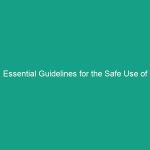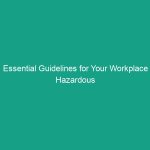Introduction
Good morning team! Today, we’re diving into an important topic that affects not just our professional lives but our personal well-being as well: Must-Know Work-Life Balance Guidelines to Boost Your Well-Being. Achieving a healthy work-life balance is crucial for our mental health, productivity, and overall satisfaction both at work and at home. So, let’s explore why this topic is essential for our Workplace Safety and how we can make adjustments to improve our lives.
Understanding Work-Life Balance
Work-life balance refers to the equilibrium between the time and energy we devote to our professional responsibilities and our personal life. Achieving this balance is vital for maintaining mental health, reducing stress, and preventing burnout. Many employees may think that working longer hours or being always available is a sign of dedication, but this can lead to decreased productivity and health issues. Misunderstanding work-life balance can also lead to conflicts in personal relationships and overall dissatisfaction.
Key Hazards, Risks, and Safety Considerations
Ignoring the principles of work-life balance can lead to various Hazards, including:
- Burnout: Prolonged stress without adequate recovery can lead to emotional exhaustion and cynicism.
- Health Issues: Chronic stress can contribute to serious health problems like heart disease, anxiety, and depression.
- Decreased Productivity: Overworking can result in diminishing returns, where the quality of work suffers.
- Workplace Conflicts: A lack of balance can lead to irritability and conflicts with colleagues due to stress and fatigue.
It’s essential to recognize these risks to foster a healthier and safer workplace. Let’s discuss how we can mitigate these risks effectively.
Best Practices, Procedures, & Actionable Advice
Here are some practical tips and strategies to help you achieve a better work-life balance:
1. Set Clear Boundaries
Establish specific work hours and communicate them with your team. Make it a practice to disconnect after work hours to recharge your mind and body.
2. Prioritize Your Tasks
Use tools like to-do lists or project management software to prioritize tasks. Focus on high-impact tasks and learn to delegate when possible.
3. Take Regular Breaks
Incorporate short breaks throughout your workday. This can be as simple as a five-minute walk or a few minutes of stretching to clear your mind.
4. Embrace Flexibility
If your job allows, consider flexible working hours or remote work options. This can help you manage personal responsibilities more effectively.
5. Practice Self-Care
Engage in activities that nourish you outside of work, such as exercise, hobbies, and spending time with loved ones. Self-care is vital for maintaining energy and focus.
6. Set Realistic Expectations
Understand your limits and don’t overcommit. It’s okay to say no to additional responsibilities that may overwhelm you.
Case Study: A Real-World Example
Consider the case of a marketing manager who consistently worked late hours to meet deadlines. Over time, they experienced burnout, leading to decreased productivity and health issues. By implementing a structured work schedule, setting boundaries, and taking regular breaks, they significantly improved their well-being and work output. This demonstrates how prioritizing work-life balance can lead to positive outcomes.
Regulations, Standards, and Compliance
Adhering to work-life balance guidelines aligns with various Workplace Health and Safety Regulations. For instance, OSHA emphasizes the importance of reducing stress and promoting worker health. By fostering a culture that prioritizes work-life balance, we not only comply with these Standards but also protect our employees’ health and productivity.
Employee Engagement & Discussion
Now, let’s open the floor for discussion. Here are a few questions to consider:
- What challenges have you faced in maintaining a healthy work-life balance?
- How do you prioritize your personal time against work demands?
- What strategies have you found effective in reducing work-related stress?
Feel free to share your thoughts and experiences. Your input is invaluable as we strive to create a healthier workplace.
Conclusion & Key Takeaways
In summary, maintaining a healthy work-life balance is essential for our well-being and productivity. By implementing clear boundaries, prioritizing tasks, and practicing self-care, we can foster a work Environment that supports not just our professional growth but our personal happiness as well. Remember, a balanced life leads to a more engaged and motivated workforce.
Thank you all for your attention and commitment to creating a safe and healthy workplace. Let’s make work-life balance a priority together!


